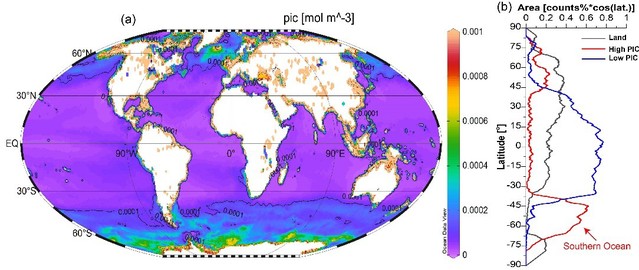Xiaobo Jin1, Chuanlian Liu1, Juan Xu1, and Xianghui Guo2
1 State Key Laboratory of Marine Geology, Tongji University, Shanghai, China,
2State Key Laboratory of Marine Environmental Science, Xiamen University, Xiamen, China
Abstract
Particulate inorganic carbon (PIC) production and export to deep ocean are important processes in water column carbonate cycling. Biochemistry investigations have shown that the seawater PIC in eutrophic high-latitude waters is contributed by marine calcifying algae coccolithophores which are constituted by the nearly monospecies Emiliania huxleyi. This allows the seawater PIC to be predicted in these high-fertility regions based on satellite remote sensing. However, in waters with low surface PIC productivity, which still account for 70% of global ocean areas, the subsurface PIC maximum may not be well disclosed by satellite. Here, with a biochemistry cruise, we investigated the seawater coccolithophore cell and coccolith abundances, degree of E. huxleyi coccolith calcification, and PIC concentration in the deep chlorophyll maximum layers in the South China Sea, with the aim to improve our understanding of PIC production in these low productivity regions. Our results demonstrate the control of nutrient levels in the water column on the geographical (horizontal) distribution of Noelaerhabdaceae coccolithophores (E. huxleyi and Gephyrocapsa oceanica) in the investigated area, as well as an insensitive response of the calcification degree of E. huxleyi coccolith to carbonate chemistry. Although Noelaerhabdaceae coccoliths were the major components of deep-sea sediment carbonate, they on average contributed to <18% of suspended PIC for the investigated seawater, indicating multiple sources of highly variable suspended PIC in the subsurface oligotrophic water. The production of Noelaerhabdaceae coccoliths greatly depends on local environments, which highlights the importance of field investigations in low-fertility areas for global PIC productivity evaluation.
Full Airticle:https://doi.org/10.1029/2021JG006657



